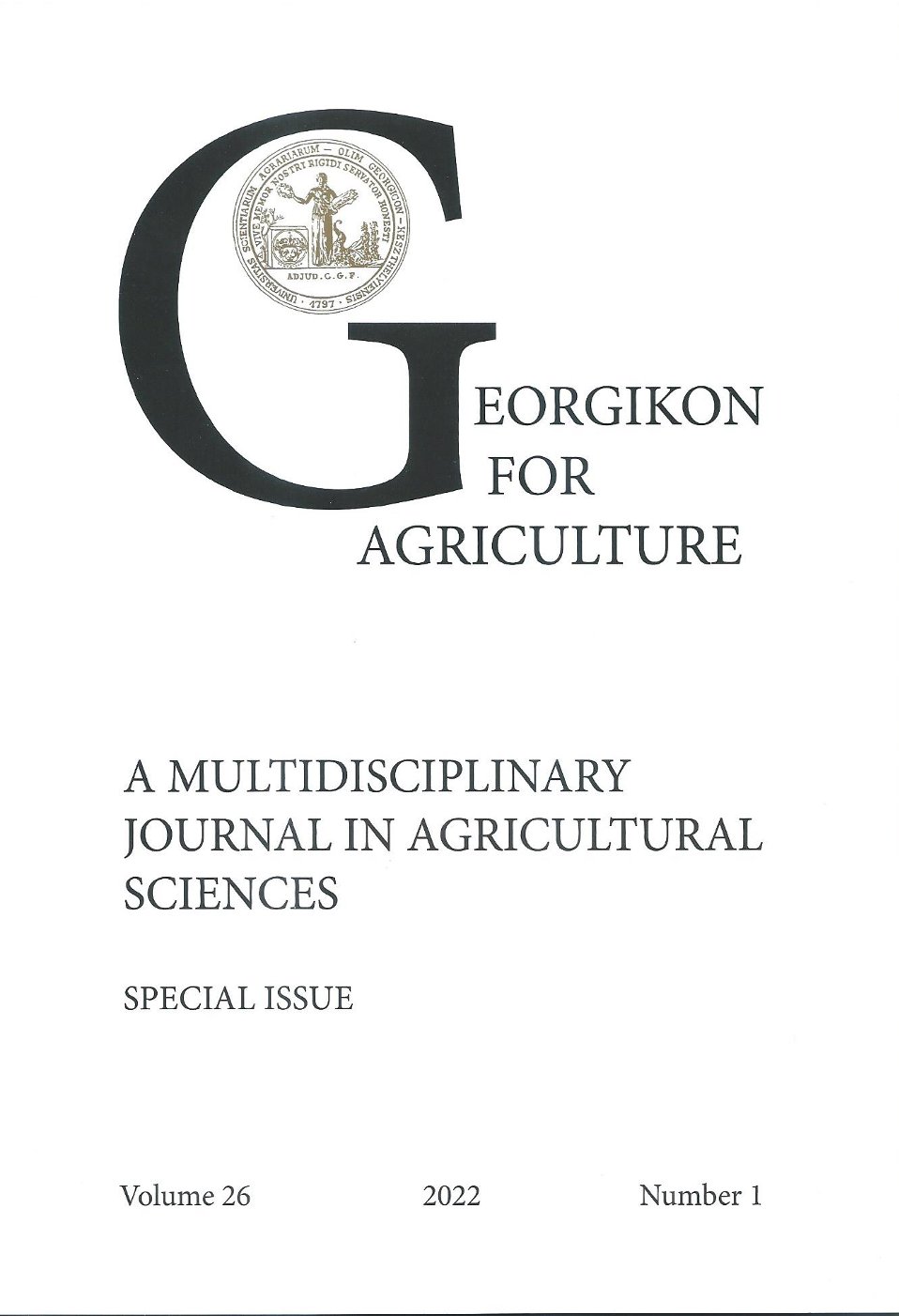A mirigyes bálványfa (Ailanthus altissima) pollenkoncentráció mérése 2019-2020 között a dél-alföldi régióban
Keywords:
Southern Great Plain Region, tree of heaven (Ailanthus altissima), pollen concentration, allergy, building damageAbstract
Nowadays, there is an increasing emphasis on the problem of invasive species. In areas where the tree of heaven (Ailanthus altissima) appears and multiplies, the original vegetation degrades and transforms. The tree of heaven of great importance in urban environments, where it causes building damage, static problems and endangers utilities. In addition, it is worth mentioning that the pollen of A. altissima is an allergenic, although less important than ragweed pollen. Pollen concentration of tree of heaven was measured in three counties of the Southern Great Plain region (Bács-Kiskun county, Csongrád-Csanád county, Békés county) with the 7-day Hirst-type (Burkard) pollen trap. The highest annual total pollen count was detected in 2019 in Bács-Kiskun county (66 pieces) and Csongrád-Csanád county (36 pieces), while in Békés county (16 pieces) in 2020. In Békés county, a trap error was detected when measuring the pollen count of Ailanthus altissima in 2019, therefore the results cannot be used. Our work draws attention to the differences in the distribution of the tree of heaven in the Southern Great Plain, based on which it can be seen that there can be more than twice the differences between the cities in terms of the total annual pollen count.
References
Ascherson, P. and Graebner, P. 1914. Synopsis der Mitteleuropäischer Flora. Leipzig-Berlin, 1. 220-370.
Barkman, J.J. 1988. New system of plant growth forms and pheno-logical plant types; In: Werger, M.J.A., Aart, P.J.M., van der During, H.J. and Verhoeven, J.T.A. (eds.): Plant Form and Vegetation Structure. SPB Academic Publishing, The Hague. 9-44.
Bartha D. 1994. Magyarország faóriásai és famatuzsálemei. Erdészet-történeti közlemények. 15. 242.
Bartosságh, J. 1841. Beobachtungen und Erfahrungen über den Götterbaum (Ailanthus glandulosa L.) - Ofen. 47.
Bartosságh J. 1843. Folytatólagos értesítés a bálványfa (Ailanthus glandulosa, Götterbaum) terjedése körül. Magyar Gazda. 3. 298-300.
Böcker, R. and Kowarik, I. 1982. Der Götterbaum (Ailanthus altissima) in Berlin (West). Berlin, Naturschutzbl. 26. 4-9.
Cariñanos, P., Casares-Porcel, M. and Quesada-Rubio, J.M. 2014. Estimating the allergenic potential in urban green zones: a case study in Granada. Landscape and Urban Planning. 123. 134–144.
Good, R. 1974. The Geography of the Flowering Plants. Longman, London.
Hegi, G. 1924. Illustrierte Flora von Mittel-Europa. VII. München.
Hu, S.Y. 1979. Ailanthus. Arnoldia. 39(2). 29-50.
Kajtor-Apatini D., Magyar D., Udvardy O., Bócsi E., Pál V. és Szigeti T. 2021. A magyarországi Aerobiológiai Hálózat tájékoztatója 2020. Nemzeti Népegészségügyi Központ (2021), Budapest.
Kovács M. és Priszter Sz. 1974. A flóra és vegetáció változása Magyarországon az utolsó száz évben. Botanikai Közlemények. 61. 185-196.
Kowarik, I. 1983. Zur Einbürgerung und zum pflanzengeographischen Verhalten des Götterbaumes [Ailanthus altissima (MILL.) SWINGLE] in französischen Mittelmeergebiet (Bas-Languedoc). Phytocoenologia. 11. 389-405.
Kowarik, I. und Böcker, R. 1984. Zur Verbreitung, Vergesellschaftungund Einbürgerung des Götterbaumes [Ailanthus altissima (MILL.) SWINGLE] in Mitteleuropa. Tuexenia. 4. 9-29.
Landenberger, R.E., Kota, N.L. and McGraw, J.B. 2007. Seed dispersal of the non-native invasive tree Ailanthus altissima into contrasting environments. Plant Ecology. 192(1). 55-70.
Magyar D., Páldy A., Szigeti T., Szilágyi A. és Orlóci L. 2020. A potenciális allergenitás felhasználási lehetősége a zöldterületek minősítésében és az allergén terhelés szabályozásában. Egészségtudomány. 64(4). 57-80.
McInnes, R.N., Hemming, D., Burgess, P., Lyndsay, D., Osborne, N.J., Skjøth, C. A. and Vardoulakis, S. 2017. Mapping allergenic pollen vegetation in UK to study environmental exposure and human health. Science of the Total Environment. 599. 483-499.
Mousavi, F., Majd, A., Shahali, Y., Ghahremaninejad, F., Shoormasti, R.S. and Pourpak, Z. 2017. Immunoproteomics of tree of heaven (Ailanthus atltissima) pollen allergens. Journal of proteomics. 154. 94-101.
Soó R. és Jávorka S. 1951. A magyar növényvilág kézikönyve. I–II. Akadémiai Kiadó. Budapest.
Szabó K. 2019. Közterületi Sorfák Jegyzéke. Magyar Díszkertészek Szövetsége. Budapest. 1-41.
Thibaudon, M., Šikoparija, B., Oliver, G., Smith, M. and Skjøth, C.A. 2014. Ragweed pollen source inventory for France-The second largest centre of Ambrosia in Europe. Atmospheric Environment. 83. 62-71.
Udvardy L. 1997. Fás szárú adventív növények Budapesten és környékén. Kandidátusi értekezés. KÉE Növénytani tanszék és SBK Budapest, kézirat
Udvardy, L. 1998. Spreading and cenological circumstances of tree of heaven [Ailanthus altissima (MILL.) SWINGLE] in Hungary. Acta Botanica Hungarica. 41. 299-314.
Udvardy L. 2004. Bálványfa (Ailanthus altissima [Mill.] swingle). In: Mihály B. - Botta-Dukát Z. (szerk.): Biológiai inváziók Magyarországon. Özönnövények. - A KvVM Természetvédelmi Hivatalának Tanulmánykötetei 9., Természet BÚVÁR Alapítvány Kiadó. Budapest, 143-160.
Udvardy O., Kajtor-Apatini D., Magyar D. és Szigeti T. 2020. A magyarországi Aerobiológiai Hálózat tájékoztatója 2019. Nemzeti Népegészségügyi Központ (2020), Budapest.
Downloads
Published
Issue
Section
License
Copyright (c) 2022 Vojnich Viktor József, Udvardy Orsolya, Kajtor-Apatini Dóra, Szigeti Tamás, Magyar Donát

This work is licensed under a Creative Commons Attribution-NonCommercial-NoDerivatives 4.0 International License.
Cikkre a Creative Commons 4.0 standard licenc alábbi típusa vonatkozik: CC-BY-NC-ND-4.0. Ennek értelmében a mű szabadon másolható, terjeszthető, bemutatható és előadható, azonban nem használható fel kereskedelmi célokra (NC), továbbá nem módosítható és nem készíthető belőle átdolgozás, származékos mű (ND). A licenc alapján a szerző vagy a jogosult által meghatározott módon fel kell tüntetni a szerző nevét és a szerzői mű címét (BY).




